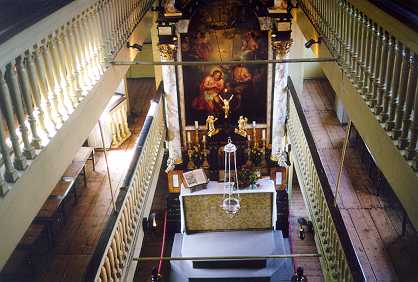February 27-March 5, 2003 issue.

The flower market on the Singel attracts many visitors who feast their eyes and cameras on the wide array of plants and fresh-cut flowers available even in winter. Somehow I always end up buying tulips, the quintessential Dutch bulb which is in fact a native to Turkey and central Asia. It was first introduced to Holland in the 16th century. Today, it brightens the canal house on Leidsekade that is my home whenever I am in this vibrant city.
One of the most fascinating of canal houses in Amsterdam is the Amstelkring Museum located in the notorious Red Light District. In the 17th century, Catholics in Holland were forbidden to worship in public. So they gathered clandestinely in private homes. The Amstelkring, also known as Our Lord in the Attic, conceals a church that remained in use until 1887. The attics of three adjoining houses were renovated to accommodate a hundred worshippers. There is no indication from the exterior of the house that a church is within. Nor entering the house gives any hint of it. Only after climbing up the stairs to the top of the house is the secret church revealed. The baroque altar soars up to the first and second galleries where there is more seating for the congregation. Across from the altar is a pipe organ. The Maria chapel is behind the altar. The rest of the house is furnished in period furniture giving a glimpse of life in the 17th century.
The golden age of Holland brought a wealth of art commissioned by the affluent merchant class. The Rijksmuseum displays the best of Dutch masters including Rembrandt, Vermeer and Frans Hals. Most visitors to the museum are familiar with Rembrandt s Nightwatch. But The Jewish Bride (1667) is more compelling. In this portrait, Rembrandt has captured the mood of a young bride whose expressive face speaks volumes as her husband holds her with tender reassurance.
At the Van Gogh Museum, you can follow the progression of Van Gogh's artistic style from his early canvas, The Potato Eaters (1885), to one of his last paintings, Wheat Field with Crows (1890). The dark palette of his early compositions develops into bright, intense colors and swirling brushstrokes that distinguish his later works. In Wheat Field with Crows, ominous dark clouds loom overhead and menacing crows fly in the background. Perhaps (and arguably) a foreboding of the artists own future, Shortly after he completed this oil painting, Van Gogh committed suicide. Van Gogh enthusiasts should visit the Kroller Mueller Museum in Otterlo (an hour by car or combination of train and bus from Amsterdam). This museum has the second largest collection of Van Gogh s oeuvres and a 21-hectare sculpture garden displaying works by Auguste Rodin and Henry Moore among others. It is well worth a visit.
Amsterdammers live in outdoors cafes. A little hint of sun and the squares fill with people. The Leidseplein and Rembrandtsplein draw the most crowds. You can sit for hours and be entertained by the constant goings on. The square turns into a stage for musicians, human statues, magicians and jugglers, all vying for attention and some change. On cold evenings, it's fun to sit with friends upstairs in one of the glass-fronted cafes and observe the square below. What a uniquely Dutch treat!
******
Getting there: Delta Airlines has direct flights from San Francisco to Amderdam's Schipol Airport. There is a train service from Schipol to Central Station in Amsterdam. Alternatively, there is a shuttle service that will take passengers to certain hotels in the city center.
Hotels: Check the VVV (Hollands tourist information organization) website at www.noord-holland-tourist.nl for lodging and rates.
Restaurants: There are many ethnic restaurants in Amsterdam serving reasonably priced meals. Try a rijstaffel (rice table) which consists of various Indonesian dishes or pannekoeken, delicious Dutch pancakes.

